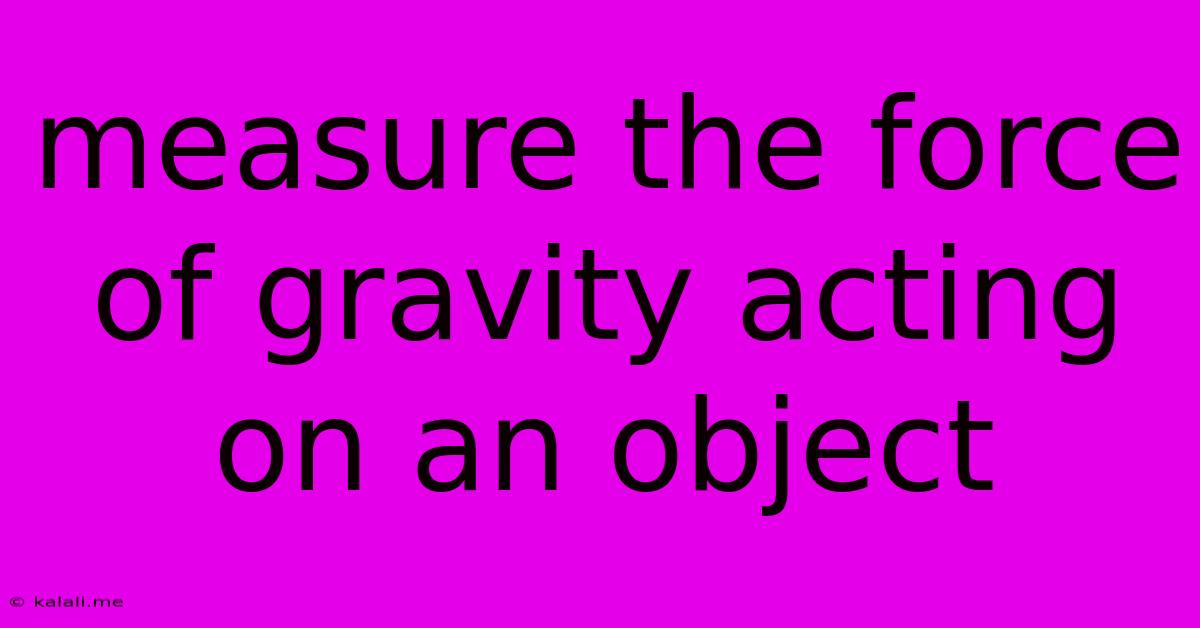Measure The Force Of Gravity Acting On An Object
Kalali
Jun 13, 2025 · 3 min read

Table of Contents
Measuring the Force of Gravity Acting on an Object
Understanding how to measure the force of gravity acting on an object is crucial in physics and numerous applications. This article will explore the fundamental concepts and methods involved, from simple experiments using readily available materials to more advanced techniques. We'll delve into the principles of weight, mass, and the gravitational constant, providing you with a comprehensive understanding of this important force.
Understanding Weight and Mass
Before diving into measurement techniques, it's vital to differentiate between weight and mass. Mass is a measure of the amount of matter in an object and remains constant regardless of location. Weight, on the other hand, is the force of gravity acting on an object's mass. This means your weight can change depending on the gravitational field strength; you'd weigh less on the moon than on Earth due to its weaker gravitational pull.
The relationship between weight (W), mass (m), and the acceleration due to gravity (g) is defined by the simple equation: W = mg. The acceleration due to gravity on Earth is approximately 9.8 m/s², often rounded to 10 m/s² for simplification in calculations.
Methods for Measuring the Force of Gravity
Several methods exist for determining the force of gravity on an object. The choice depends on the accuracy required and available resources.
1. Using a Spring Scale (Simple Measurement)
This is the most straightforward approach for measuring weight. A spring scale directly measures the force acting on the spring, which in this case is the weight of the object. Simply hang the object from the spring scale and read the value. Remember that the reading represents the weight, which is the force of gravity. To find the mass, you would divide the weight by the acceleration due to gravity (g).
- Advantages: Simple, inexpensive, readily available.
- Disadvantages: Limited accuracy, affected by spring calibration and environmental factors.
2. Using a Balance Scale (Measuring Mass, Indirectly Weight)**
While a balance scale doesn't directly measure weight, it measures mass. By comparing the object's mass to known standard masses, you can determine its mass. Then, using the equation W = mg, you can calculate the weight (force of gravity).
- Advantages: More accurate than a spring scale for mass determination, less susceptible to environmental factors.
- Disadvantages: Doesn't directly measure weight; requires calculation.
3. Advanced Techniques (Precise Measurement)**
For highly precise measurements, more sophisticated techniques are employed. These include:
- Gravimeters: These instruments precisely measure the acceleration due to gravity (g) at a specific location. By knowing the mass of an object, you can then calculate its weight using W = mg. Gravimeters are used in geophysics and other scientific fields requiring highly accurate gravity measurements.
- Pendulum Experiments: The period of a pendulum's swing is related to the acceleration due to gravity. By carefully measuring the period, the value of 'g' can be determined. This method allows for a relatively precise measurement of gravitational acceleration.
Factors Affecting Gravity Measurements
Several factors influence the accuracy of gravity measurements:
- Altitude: Gravitational force decreases with increasing altitude.
- Latitude: The Earth is not perfectly spherical, resulting in slight variations in gravity with latitude.
- Local Density Variations: Variations in the density of the Earth's crust beneath the measurement location can affect gravitational force.
Conclusion
Measuring the force of gravity acting on an object is a fundamental concept in physics. While a simple spring scale provides a basic measurement of weight, more advanced techniques are needed for precise determinations. Understanding the interplay between mass, weight, and the acceleration due to gravity is crucial for accurate measurements and a deeper understanding of this ubiquitous force. Regardless of the method chosen, remember to consider the potential sources of error and strive for accuracy in your measurements.
Latest Posts
Latest Posts
-
In Dna Thymine Is Always Paired With
Jun 14, 2025
-
What Element Has The Atomic Number 17
Jun 14, 2025
-
Light From Sun To Earth Time In Minutes
Jun 14, 2025
-
A Unit Used To Measure The Intensity Of A Sound
Jun 14, 2025
-
How Many Feet Wide Is A Tennis Court For Doubles
Jun 14, 2025
Related Post
Thank you for visiting our website which covers about Measure The Force Of Gravity Acting On An Object . We hope the information provided has been useful to you. Feel free to contact us if you have any questions or need further assistance. See you next time and don't miss to bookmark.